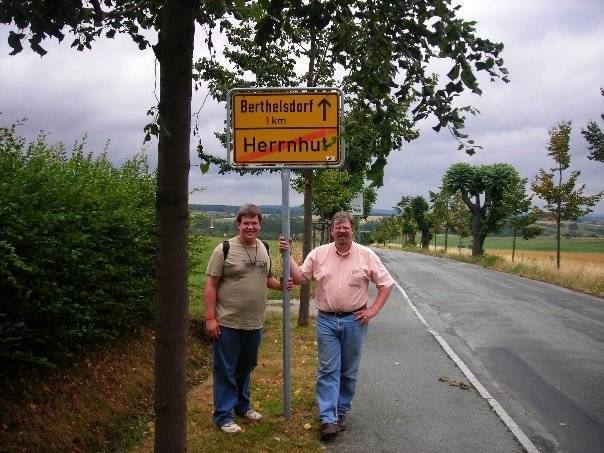Time zone CET/CEST (UTC+1/+2) Area 29.76 km² Population 3,523 (31 Dec 2008) Dialling code 035873 | Elevation 344 m (1,129 ft) Postal codes 02747 Local time Friday 2:50 PM Postal code 02747 | |
 | ||
Weather 5°C, Wind NW at 16 km/h, 83% Humidity | ||
Herrnhut germany moravian church carol cantrell sings
Herrnhut (Sorbian: Ochranow; Czech: Ochranov) is an Upper Lusatian town in the Görlitz district in Saxony, Germany, known for the community of the Moravian Church established by NIcolas Ludwig, Count von Zinzendorf in 1722.
Contents
- Herrnhut germany moravian church carol cantrell sings
- Map of Herrnhut Germany
- Geography
- Subdivisions
- History
- Population
- Coat of arms
- Culture
- Economy
- Notable people
- References
Map of Herrnhut, Germany
Geography
It is located in the historic Upper Lusatia region, on the road Bundesstraße 178, and on the Löbau–Zittau railway line. Herrnhut is about 10 km (6.2 mi) south-east of Löbau, 15 km (9.3 mi) north-west of Zittau, and 25 km (16 mi) south-west of the district capital Görlitz.
The municipality borders on, among other municipalities, Oderwitz.
Subdivisions
Herrnhut is also the name of the largest town in the municipality. Since 1 January 2013, when Berthelsdorf was incorporated, the municipal area contains 11 subdivisions:
History
Herrnhut proper was founded in the early 18th century by German speaking religious refugees of Bohemian Brethren from Margraviate of Moravia. The Unity of the Brethren arose after the reformer Jan Hus had been burnt at the stake during the Council of Constance in 1415. In the 18th century, they had to face the stern Counter-Reformation measures enacted in the Lands of the Bohemian Crown by the Habsburg rulers. From 1722 refugees came to Upper Lusatia, held by the Electors of Saxony since the 1635 Peace of Prague. After meeting with their leader Christian David, a Moravian missionary, the German nobleman Count Nikolaus Ludwig von Zinzendorf (1700–1760) invited them to settle on his extended Berthelsdorf estates.
Shortly afterwards, David built the first home in what was to become Herrnhut. Zinzendorf himself had a new residence erected here in 1725–27). From Herrnhut the community spread to Rixdorf near Berlin, the former Marienborn monastery near Büdingen, to Herrnhaag, to Norden. Numerous daughter churches arose over Northern Europe; in 1738, the missionary station of Genadendal was founded in South Africa, Christiansfeld in Denmark followed in 1771.
Herrnhut holds a prominent place in the history of Protestantism, as well as the broader history of Christianity. Count von Zinzendorf's community impacted John Wesley in creating Methodism. More importantly, it contributed to the rise of Evangelicalism, a broad interdenominational movement of 300 million people all over the globe.
Population
According to the Saxon state congress in 1777, Herrnhut contained 76 homes.
In the mid-19th century the population rose above 1,000, and after World War II it reached more than 2,000. Since the 1950s there has been a decline in population, which was compensated for by the incorporation of neighboring municipalities.
Coat of arms
The Herrnhut coat of arms is blue and white, showing the tower of the Altan (the lookout tower) atop the Hutberg hill above the city. The name of Hutberg hill ("Hill of Watching") suggested the name of the Moravian settlement founded by these exiles on the Zinzendorf estate in 1722. Herrn Hut means "the Lord's Watchful care".
Culture
Herrnhut has a church and two museums, including a museum of local history. It is the center of the worldwide Moravian Church, the Unitas Fratrum, in German Brüder-Unität or Brüdergemeine. Many European languages have named the Moravian Church movement directly after Herrnhut, for example hernhuutlus in Estonian, herrnhutilaisuus in Finnish, hernhūtieši in Latvian and herrnhutismen in both Norwegian and Swedish.
The former Herrnhut train station on the decommissioned railway line Zittau-Löbau has been turned into an art gallery.
From Herrnhut, the Moravian star decoration has spread over Europe and America.
Economy
Its economy is based on church administration, education, tourism and manufacturing, including a 26-pointed star that is often hung in windows and on porches during the Christmas season, which has been produced for over 150 years. It is called the Moravian Advent Star (Herrnhuter Adventsstern).
